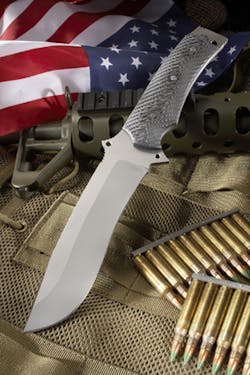New M3 Knife from Mil-Tac
Everyone seems to have their own idea of what a "good" knife looks like and how it functions. Many folks lay out the requirements for their ideal knife in complete detail right down to how many millimeters thick the tang should be and how many teeth there should be in the serrations. I'm a simple kind of guy: the knife should be strong; it should stand up to abuse; the grip should be secure even when wet; I should be able to hammer with it; I should be able to perform small cutting chores and minor chopping chores. I should be able to use it as a weapon if I must. The Miller Marine Model - or "M3" from Mil-Tac meets all my requirements.
The Miller Marine Model, or M3, shown above, was designed from the outset as a general purpose field knife. The blade is 5.5" with a soft curve and just enough belly to assist with pressing into cuts. Tang thickness is 3/16" to within 1/2" of the tip when it begins to taper. Because of the blade shape, the 5.5" blade length actually allows for just about 6" of cutting edge. The balance of the knife is 5.5" of grip with shaped slaps of G10 screwed on.
The grip portion is ergonomically shaped with a good finger groove and a decent press point at the top of the hilt - with ridges to increase friction when you use your thumb to push into cuts. As you can see from the photo there are two lash holes - one at either hilt tip - and a lanyard hole near the pommel. The grip slabs never get closer than 3/8" to the pommel. Add that to the pommel surface that measures 3/16"x1" and you get a decent surface for hammering / pounding.
The sheath is made from Spec-Ops Brand, a name well known in the industry. It's nylon with steel hardware, a hard plastic insert to protect the sheath from the blade edge, and a utility pouch on the outside that fits multi-tools or most folding blades. The hard plastic insert is anchored so as not to slide around (or out), and the sheath also comes with multiple mounting options, paracord and a cord lock.
As with any other knife I decide to test, abuse testing is part of the program. First up is the cutting test. The M3 knife I had to test - and, in fact, all that I've seen - has a plain edge. No serrations. Out to my shed I went, there to cut everything from fishing line to string to twine, paracord, 1/2" hemp and some 11mm poly-synthetic rope. No issues with any of that. Next comes chopping...
With the little bit of added weight near the tip because of the blade curve, hacking into something is a bit easier than with bowie or spear point blades. What could I find to hack up? I have a couple old 5 gallon plastic buckets - the kind painters get putty in - along with various bits of scrap wood and cardboard boxes. Cardboard normally dulls a blade pretty quick, so I started with that. With a few good swipes I managed to reduce two boxes to cardboard shreds. Next was the wood. I had a couple pieces of pressure treated 2x4 that really took some good hits. The blade got stuck once or twice - but pride out easy enough. Then came the plastic. Those buckets aren't soft and aren't easy to cut up.
By the time I was done I had put some serious wear marks on the blade flats. The edge showed use but not excessively so. Just to see how badly I had dulled the blade, I went back and tried cutting various pieces of string, twine and rope again. I noticed a little bit of difference but not a lot. Back inside I got out my diamond stick sharpener and dressed up the edge. It didn't take long and I had it looking in fine shape again.
Now my test blade was one of the first production run knives. It's my understanding that the knives will be available in two variations. One will be made from 440C Steel with the other from CPM S30V stainless steel. Obviously there will be different price points for these knives and I'm waiting to see final pricing from Mil-Tac.
